Gloucester City Hall
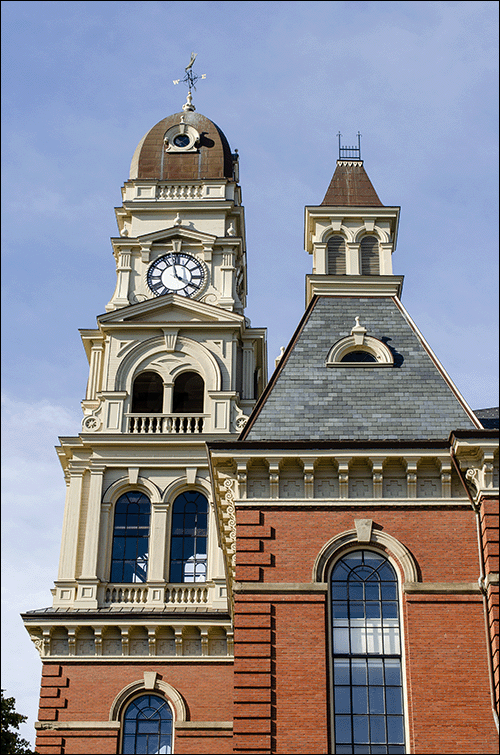
The sign outside this building states:
City Hall, a Victorian building showing both French and English influences, was designed by Gridley J.F. Bryant and his associate Louis P. Rogers.
Basing their plan on the Town House built on this site a few years earlier and burned beyond repair in 1869, Bryant & Rogers gave their new Town House (Gloucester didn’t become a city until 1873) a more ornate exterior but virtually recreated the interior of the previous building.
The Town House was built to be an entertainment center, as well as the seat of local government. The design included a large second floor auditorium with its raised stage, graceful balcony & ornate pressed ceiling. It was the building’s most distinguished interior space. Among the people who appeared were Buffalo Bill, P.T. Barnum, and John L. Sullivan.
Nahant Life-Saving Station
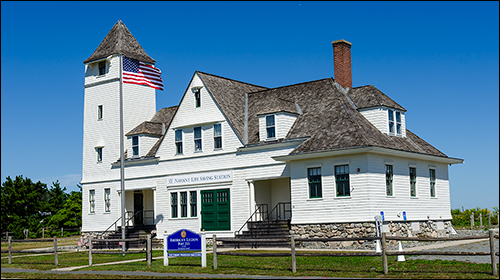
The Massachusetts Humane Society was founded in 1786 by citizens concerned with deaths resulting from shipwrecks and drownings near the coast. It was realized that shore-based assistance could save lives, and small lifeboat stations were established, with rescue equipment used by volunteer. In 1848, the federal government became involved, and funding became available for life-saving services and for more, better equipped stations. In 1878, these lifesaving stations were formally recognized as a federal agency called the Life-Saving Service; and in 2015, this Life-Saving Service merged with the Revenue Cutter Service, creating the United States Coast Guard.
By the early 1900s, the Massachusetts Humane Society operated more than 50 stations along the coast. The Nahant Life-Saving Stations is one of these stations. It is now the property of the Town of Nahnat and is leased to the Nahant Preservation Trust. The Mortimer Robbins American Legion occupies first floor space, and an office tenant is on the second floor of the Station. The former Boat room and grounds are rented for events based on a strict functions policy developed in conjunction with the community.
The Station property was listed on the National Register of Historic Places in 2012.
References:
Stories of Lynn
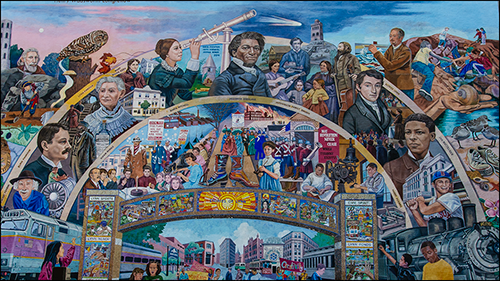
The Stories of Lynn mural covers the side of the Lynn Arts Building in downtown Central Square. It illustrates the history of Lynn and is the focal point in Frederick Douglas Park. The paintings include Frederick Douglas, who resided in Lynn in the 1840s; Mary Baker Eddy, who discovered Christian Science while living in Lynn; Charles H. Woodbury, one of a group of artists known as Lynn Beach painters. The mural celebrates its GE workers, its shoe industry, its Native American heritage, its grand cinema, its poets, its athletes, and more.
Yetti Frenkel’s Web site includes a detailed description of the mural and the process by which it was created.
The Lynn Mural Project was a collaborative effort of David Fichter, Yetti Frenkel and Joshua Winer. The mural was created in two phases. During the phase one, the artists worked with students from the Lynn middle and high schools to create a mosaic arch about Lynn today from the youth perspective. During phase two, the artists painted the history of Lynn, focusing on stories and people representing the creative spirit of the city. The project was funded by the New England Foundation for the Arts and the Massachusetts Cultural Council.
—David Fichter
The city of Lynn, Massachusetts has a rich industrial history and a diverse population. LynnArts, a citywide cultural institution, commissioned this work of public art to draw attention to the city's cultural heritage. Working in collaboration with fellow muralists David Fichter and Yetti Frenkel, we organized six independent artist-in-residencies in the Middle School and High Schools of Lynn. At each school we worked with the students to create design drawings, then make mosaic panels that we installed outside on the arch. Above the arch we [painted] a mural that tells the complete history of the city, on a wall that is sixty feet by sixty feet square.
This is an ambitious multi-year project that is a centerpiece for the city and includes the work of more than six hundred students.
—Joshua Winer
References:
- “Lynn Stories Mural,” Yetti Frenkel Art. Link
- “Lynn Mural Project: Stories of Lynn,” David Fichter, Professional Muralist. Link
- “The Stories of Lynn,” School Mosaics & Community Mosaics with Joshua Winer, Artist and Teacher. Link
- “Lynn Stories Mural,” Lynn Museum & Historical Society. Link
- “Frederick Douglas Memorial Park,” Downtown Lynn Cultural District. Link
- “Frederick Douglas Park,” Halvorson | Tighe&Bond Studio. Link
International Sand Sculpting Festival, Revere Beach
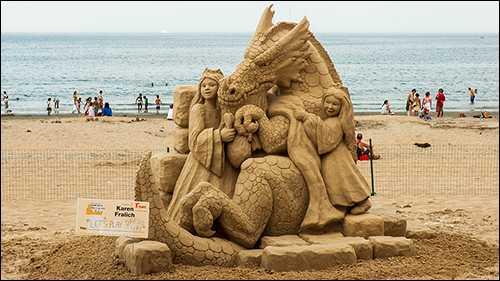
In the words of the Revere Beach Partnership, the International Sand Sculpting Festival is a free event open to the public [that] draws large crowds from around the world. At the heart of this three-day festival is a Master Sand Sculpting Competition. Over 4 days, 15 world-renowned sand sculptors compete for first place! In addition to the competition pieces, there is a large centerpiece sculpture that displays the sculptor’s collaboration around a centralized theme and displays event sponsors. This beautiful centerpiece is the most photographed attraction at the beach. In addition to world-class artists, the event also features a full entertainment schedule with live music, an interactive kid’s zone, fireworks, amusement rides, and a food truck village that feature cuisines from all over the world.
The Revere Beach Partnership is a 501(c)(3) non-profit organization, staffed by volunteers, whose mission is to preserve and enhance America’s first public beach for the enjoyment of all.
In addition to the Sand Sculpting Festival held in July, the organization also promotes several other events: Winter Wonderland, featuring ice sculptures, in February; a Kite Festival in May; a Summer Music Series during June, July, and August; a one-day Art Festival in September; and a 5K race—the Pumpkin Dash—in October. For details, visit the Revere Beach Partnership Web site.
References:
Fort Pickering Light, Winter Island, Salem
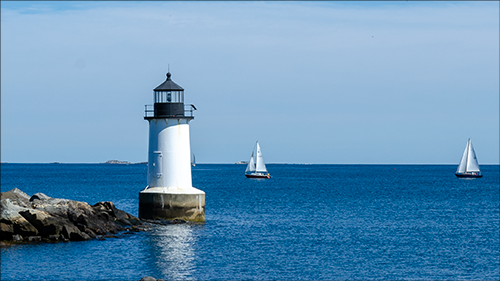
Fort Pickering Light was established in 1871, the same year that nearby Derby Wharf Light in Salem Harbor. The Light takes its name from nearby Fort Pickering, an historic fort dating back to 1643. The fort is situated on Winter Island, and the Light also is known as Winter Island Light.
In 1934, a Coast Guard erected an airplane hangar on Winter island, and later the lighthouse keeper’s house became the officer’s club for the Coast Guard Air Station on the island. The Coast Guard left Winter Island in 1969, the Light was replaced by an offshore buoy, and the Light tower fell into disrepair.
In the 1980s, concerned citizens and businesses formed the Fort Pickering Light Asociation, the lighthouse was repaired, and Fort Pickering Light was relighted in 1983. In 1995, the electrical system was converted to solar power, and the Light produced a white flash lasting four-tenths of a second, every four seconds. The lighthouse has underwent subsequent improvements as Winter Island has been developed as a recreational and camping facility for Salem and visitors.
References:
Old Town Hall, Salem
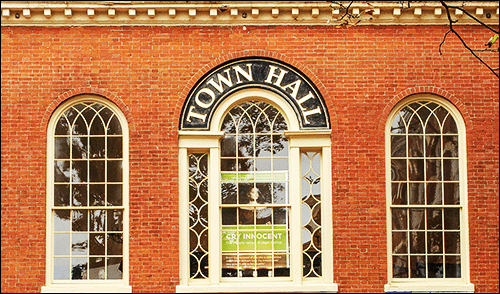
Stated on the City of Salem Web site:
Old Town Hall is the earliest surviving municipal structure in Salem, Massachusetts. Built in 1816, this beautiful federal style building is located in the heart of historic downtown Salem. Nestled between the Essex Street pedestrian mall and cobblestoned Front Street, Old Town Hall is the crowning jewel of Derby Square.
The building and its Derby Square site maintain historical associations with Salem’s prominent 18th and 19th century Derby family for whom Derby Square, Derby Wharf, Derby Street and the two waterfront Derby houses were named. The building contains elements attributed to both Charles Bulfinch, the most influential Boston architect of the Federal period, and Samuel McIntire, Salem’s renowned architect and woodcarver. The structure was saved from demolition by Salem preservation architect Philip Horton Smith in the 1930s and underwent a partial restoration in the 1970s.
The two-story, brick structure features Palladian-style windows, carved wood details, antique chandeliers, decorative columns, and hardwood floors. The second floor, known as the Great Hall, has always been used as a public hall, and contained Town offices until 1837. The first floor, the ‘Colonnade’, was originally designed as a public market. Old Town Hall is owned by the City of Salem and managed by the City’s Senior Planner of Arts & Culture within the Department of Planning and Community Development. The address of the building is 32 Derby Square, Salem MA 01970.
References:
Elihu Thomson Administrative Building, Swampscott
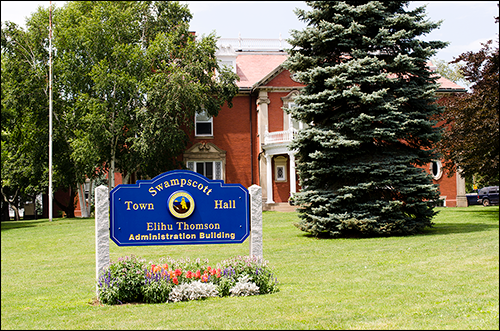
The Elihu Thomson Administration Building serves as Swampscott’s municipal town hall. This Georgian Revival house was designed by architect James Templeton Kelly for Professor Elihu Thomson in 1889. Thomson moved his business and family to Massachusetts and chose this site in Swampscott. This lot, with sweeping views to the Monument and Kings Beach, was part of a new subdivision designed by the firm of famous landscape architect, Frederick Law Olmsted. Thomson was an extraordinary inventor of electrical systems and engineering, becoming the third largest patent holder in America, founding the Thomson-Houston Electric Company and later co-founder of General Electric.
Dr. Elihu Thomson lived in Swampscott with his wife, Mary Louise and their four sons. This home, constructed of brick in the Georgian Revival Style, included a bridge once connected from the second story to a carriage house. Over the carriage house, Thomson made his laboratory where he built models of steam boilers, electric ship propulsion, turbines, and hydraulic drives for automobiles. He performed experimental work on x-rays, high-powered lenses, refrigeration, arc lighting, and electrical measurements for instruments of many applications.
In 1940, a study committee was formed to locate a new space for Swampscott’s expanding town administration, the Town Hall located on Burrill St at this time. In 1944, the committee suggested the Town purchase the Thomson home; the Thomson heirs would sell the home to the town for $37,000 as a partial gift.
J. William Beal & Sons were engaged as architects to oversee the conversion of the house into a workable town hall. The Elihu Thomson Administrative building has since been renovated several times to add HVAC, accessibility, sprinkler system, a 2-story connection to the carriage house, elevator, and more, but most of the interior details have been retained.
The Elihu Thomson House was designated a National Historic Landmark in 1976 and adopted into Swampscott’s Local Historic District in 2014.
Reference:
Elihu Thomson House,Town of Swampscott Web site. Link
Swampscott Railroad Depot (aka Swampscott Station)
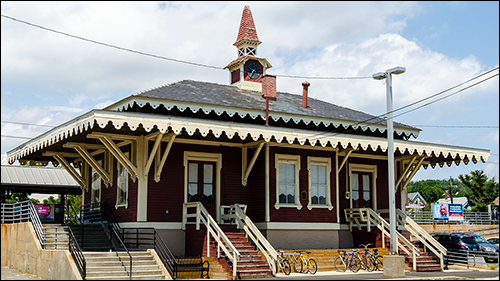
Constructed in 1868, the Swampscott Railroad Depot is the only remaining station on the Swampscott branch line. The ticket office in the building was closed in 1952, and train service on the Swampscott branch line was discontinued in 1959. Architecturally, the station represents Stick Style, a late 19th-century style commonly used in houses, train stations, life-saving stations, and other buildings from that era. The stickwork decoration consists of narrow planks applied over the wall’s clapboards. A similar but smaller station, the Phillips Beach Station, also was on the Swampscott branch, but that building has been demolished. The larger station escaped that fate in the 1980s when volunteers raised funds to fix the building’s exterior, and in 1998 got the building listed in the National Register of Historic Places.
The Marblehead branch of the railroad line has been converted to the Marblehead Rail Trail, and a portion of the Swampscott line has undergone a similar conversion.
References:
Swampscott Mariners Memorial (Tedesco Anchor)
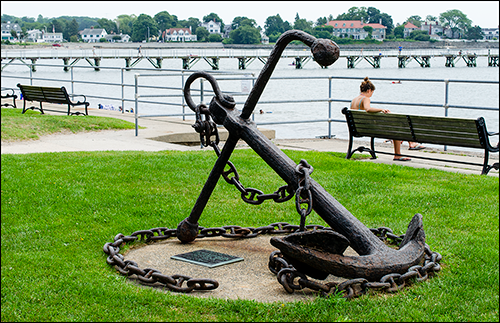
The plaque next to this anchor states:
In Memory Of The Men Of Swampscott Who Lost Their Lives At Sea
This Anchor Believed To Be From The Bark “Tedesco” Wrecked January 18, 1857
And Found Off Swampscott August, 1968 By
Mark Cheevers Mark O’Grady David Mair
William Clarke Kevin Cheevers John Davidson
Was Placed Here By The Board Of Selectman
Arthur J. Palleschi Francis J. Cassidy Edward K. Hempel
And The Historical Committee
March 1971